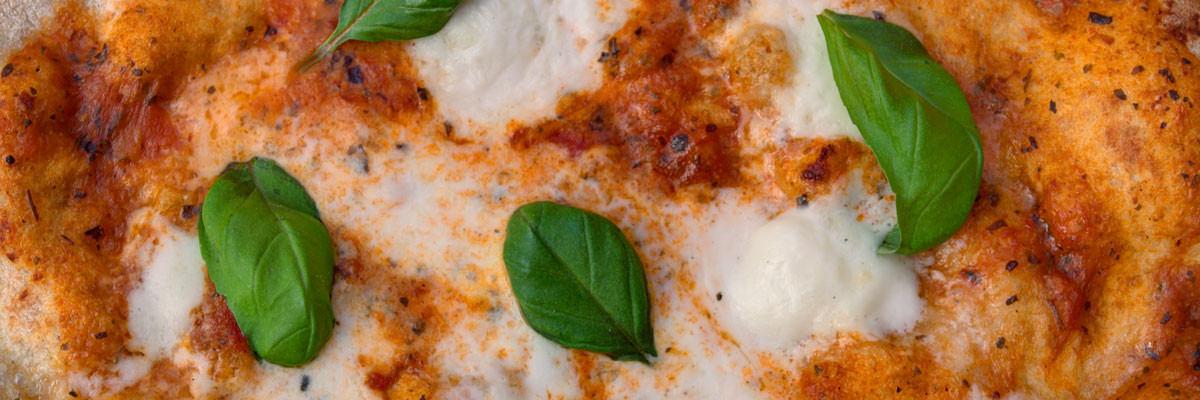 The Pizza Wiki
The Pizza Wiki
You are what you eat and it’s your right to know what you eat. In our Wiki page you can find some detailed information about the ingredients, techniques and other fancy words that we use in our portable restaurant.
Sourdough
Sourdough is a bread product made by a long fermentation of dough using naturally occurring lactobacilli and yeasts. In comparison with breads made with cultivated yeast, it usually has a mildly sour taste because of the lactic acid produced by the lactobacilli. Sourdough is a dough containing a Lactobacillus culture in symbiotic combination with yeasts. It is one of the principal means of biological leavening in bread baking, the others using cultivated forms of yeast. It is important in baking rye-based breads, where yeast does not produce comparable results. Compared to breads made with baker’s yeast, it produces a mildly sour taste because of the lactic acid produced by the lactobacilli. The most commonly used yeast species in the production of sourdough are Kazanchastania exigua (Saccharomyces exiguous), Saccharomyces cerevisiae, Candida Milleri, and Candida humilis. Read more
Spelt
Spelt, also known as dinkel wheat or hulled wheat is a species of wheat cultivated since 5000 BCE. Spelt was an important staple in parts of Europe from the Bronze Age to medieval times; it now survives as a relict crop in Central Europe and northern Spain and has found a new market as a health food. Spelt contains about 57.9 percent carbohydrates (excluding 9.2 percent fibre), 17.0 percent protein and 3.0 percent fat, as well as dietary minerals and vitamins. As it contains a moderate amount of gluten, it is suitable for some baking. However, because spelt contains gluten it is not suitable for people with coeliac disease. In comparison to hard red winter wheat, spelt has a more soluble protein matrix characterized by a higher gliadin:glutenin ratio. Spelt flour is becoming more easily available, being sold in British supermarkets for a number of years. Spelt pasta is also available in health food stores and specialty shops. Spelt bread is sold in health food shops and some bakeries in an increasing variety of types of loaf, similar in colour to light rye breads but usually with a slightly sweet and nutty flavour. Biscuits, crackers, and pretzels are also produced, but are more likely to be found in a specialty bakery or health food store than in a regular grocer’s shop.A loaf of spelt bread Dutch Jenever makers distill with spelt. Beer brewed from spelt is sometimes seen in Bavaria and Belgium and spelt is distilled to make vodka in Poland and elsewhere. Flour from sprouted spelt grains is increasingly available throughout North America in grocery and health food stores. In Germany, spelt loaves and rolls (Dinkelbrot) are widely available in bakeries as is spelt flour in supermarkets. The unripe spelt grains are dried and eaten as Grünkern (“green grain”). Spelt is more expensive than modern wheats, first because it is a minority product, but also because it requires the extra stage of husk removal before milling. Read more
Nutrition Information: to be added
Dark Rye
Rye (Secale cereale) is a grass grown extensively as a grain, a cover crop and as a forage crop. It is a member of the wheat tribe (Triticeae) and is closely related to barley (Hordeum) and wheat (Triticum). Rye grain is used for flour, rye bread, rye beer, crisp bread, some whiskeys, some vodkas, and animal fodder. It can also be eaten whole, either as boiled rye berries, or by being rolled, similar to rolled oats.Rye bread, including pumpernickel, is a widely eaten food in Northern and Eastern Europe. Rye is also used to make crisp bread. Rye flour is high in gliadin but low in glutenin. It therefore has a lower gluten content than wheat flour. It also contains a higher proportion of soluble fiber. Alkylresorcinols are phenolic lipids present in high amounts in the bran layer (e.g. pericarp, testa and aleurone layers) of wheat and rye (0.1–0.3% of dry weight). Read more
Nutrition Information: to be added
Einkorn
Einkorn wheat is one of the earliest cultivated forms of wheat, alongside emmer wheat (T. dicoccum). Grains of wild einkorn have been found in Epi-Paleolithic sites of the Fertile Crescent. It was first domesticated approximately 7500 BC (7050 BC), in the Pre-Pottery Neolithic A (PPNA) or B (PPNB) periods.[1] Evidence from DNA finger-printing suggests einkorn was domesticated near Karaca Dağ in southeast Turkey, an area in which a number of PPNB farming villages have been found. Its cultivation decreased in the Bronze Age, and today it is a relict crop that is rarely planted, though it has found a new market as a health food. It remains as a local crop, often for bulgur (cracked wheat) or as animal feed, in mountainous areas of France, Morocco, the former Yugoslavia, Turkey and other countries. It often survives on poor soils where other species of wheat fail. Einkorn wheat (from German Einkorn, literally “single grain”) can refer either to the wild species of wheat, Triticum boeoticum, or to the domesticated form, Triticum monococcum. The wild and domesticated forms are either considered separate species, as here, or as subspecies of T. monococcum. Einkorn is a diploid species of hulled wheat, with tough glumes (‘husks’) that tightly enclose the grains. The cultivated form is similar to the wild, except that the ear stays intact when ripe and the seeds are larger. Read more
Nutrition Information: to be added
Semolina
Semolina is the coarse, purified wheat middlings of durum wheat used in making pasta, breakfast cereals, puddings, and couscous. The term semolina is also used to designate coarse middlings from other varieties of wheat, and from other grains, such as rice and maize. As an alternative to corn meal, semolina can be used to flour the baking surface to prevent sticking. In bread making, a small proportion of durum semolina added to the usual mix of flour is said to produce a tasty crust. Read more
Nutrition Information: to be added
Buffalo mozzarella
Buffalo mozzarella (Italian: mozzarella di bufala) is a mozzarella made from the milk of the domestic Italian water buffalo. It is a product traditionally produced in Campania, especially in the provinces of Caserta and Salerno. The term mozzarella derives from the procedure called mozzatura which means “cutting by hand”, separating from the curd, and serving in individual pieces, that is, the process of separation of the curd into small balls. It is appreciated for its versatility and elastic texture and often called “the queen of the Mediterranean cuisine”, “white gold” or “the pearl of the table”, in compliance with the finest food quality and taste of the product. The buffalo mozzarella sold as Mozzarella di Bufala Campana has been granted the status of Denominazione di origine controllata (DOC – “Controlled designation of origin”) since 1993. Since 1996 it is also protected under the EU’s Protected Designation of Origin and Protected Geographical Indication schemes. The protected name requires that it may only be produced with a traditional recipe in select locations in the regions of Campania, Lazio, Apulia and Molise. Generally, buffalo mozzarella is enjoyed with calzone, vegetable, salad (for example, insalata Caprese), on pizza (a low moisture content buffalo mozzarella is preferred), on grilled bread, or by itself accompanied by olive oil. Read more
Nutrition Information: to be added
Pepperoni
Pepperoni, also known as pepperoni sausage, is an American variety of salami, usually made from cured pork and beef mashed together. Pepperoni is characteristically soft, slightly smoky, and bright red in color. Thinly sliced pepperoni is a popular pizza topping in American-style pizzerias and is used as filling in the West Virginia pepperoni roll. It is also used to make some varieties of submarine sandwiches.Pepperoni is a cured sausage similar to the spicy salamis of southern Italy, such as salsiccia Napoletana piccante, a spicy dry sausage from Naples, or the soppressata from Calabria. The main differences are that pepperoni has a finer grain (akin to salami of Milan, a spiceless regional variant of salami), is usually softer, and is produced with the use of an artificial casing (instead Italian salami are produced using natural gut for casing). Pepperoni is mass-produced to meet the demand for the sausage.
Nutrition Information: to be added
Sobrasada De Mallorca
Sobrasada is a raw, cured sausage from the Balearic Islands made with ground pork, paprika and salt and other spices. Sobrassada, along with botifarró are traditional Balearic sausage meat products prepared in the laborious but festive rites that still mark the autumn and winter pig slaughter known as a matança in Majorca and Eivissa. The chemical principle that makes sobrasada is the dehydration of meat under certain weather conditions (high humidity and mild cold) which are typical of the late Balearic autumn. After centuries of Muslim rule with pork banned, Majorca quickly returned to pork consumption in the Middle Ages, with the key ingredient paprika added after the discovery of America in the 15th century. Sobrassada is thought to have originated and expanded, as a culinary concept, in the Aragon Crown-controlled Western Mediterranean (Sicily, Balearic Islands, Sardinia) after the 14th century, as similar sausages are still made in this region. In a traditional Mediterranean diet, containing little meat, as Majorca had until the 1950s, sobrassada and related pork sausages were the main and sometimes only sources of pork for Majorcans. Larger meat cuts such as pork or lamb roasts, pork steaks or beef cuts were largely festive dishes, or restricted to the well-off. Even today dishes such as porcella rostida, a whole roasted suckling pig, are only served on special occasions. Read more
Nutrition Information: to be added
Chorizo
Chorizo (Spanish) or chouriço (Portuguese) is a term originating in the Iberian Peninsula encompassing several types of pork sausages. Traditionally, chorizo is encased in natural casings made from intestines, a method used since Roman times. Chorizo can be a fresh sausage, in which case it must be cooked before eating. In Europe, it is more frequently a fermented, cured, smoked sausage, in which case it is often sliced and eaten without cooking, and can be added as an ingredient to add flavour to other dishes. Spanish chorizo and Portuguese chouriço get their distinctive smokiness and deep red color from dried smoked red peppers (pimentón/pimentão). Due to culinary tradition and the high cost of imported Spanish smoked paprika, Mexican chorizo is usually made with native chili peppers of the same Capsicum annuum species, used abundantly in Mexican cuisine. In Latin America, vinegar also tends to be used instead of the white wine usually used in Spain. Chorizo can be eaten sliced in a sandwich, grilled, fried, or simmered in liquid, including apple cider or other strong alcoholic beverage such as aguardiente. It also can be used as a partial replacement for ground (minced) beef or pork. Spanish-style tapas bars that serve traditional Spanish-style chorizo have gained in popularity in recent years, and now appear in many large cities throughout North America and in parts of Europe. Read more
Nutrition Information: to be added
Pesto
Pesto is a sauce originating in Genoa in the Liguria region of northern Italy (pesto genovese), and traditionally consists of crushed garlic, basil, and European pine nuts blended with olive oil, Parmigiano Reggiano (Parmesan cheese), and Fiore Sardo (cheese made from sheep’s milk). Pesto is traditionally prepared in a marble mortar with a wooden pestle. First, garlic and pine nuts are placed in the mortar and reduced to a cream, then the washed and dried basil leaves are added with coarse salt and ground to a creamy consistency. Only then is a mix of Parmigiano-Reggiano and Pecorino added. To help incorporate the cheese a little extra-virgin olive oil is added. In a tight jar (or simply in an air-tight plastic container), covered by a layer of extra-virgin olive oil, pesto can last in the refrigerator up to a week, and can be frozen for later use. Read more
Nutrition Information: to be added




